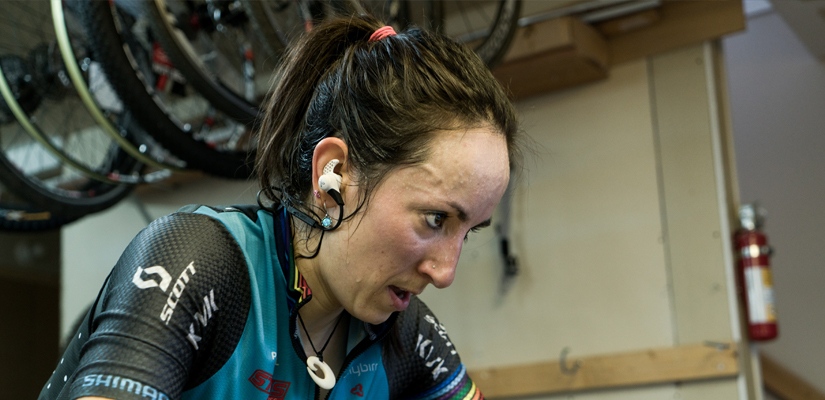Breathing 101: How to Breathe More Efficiently While Cycling

Use breathing to your advantage. You can improve performance, mental stamina, and focus with respiratory muscle training and circumferential breathing techniques.
For more information on training check out Ask a Cycling Coach Ep 257.
Find links to mentioned studies and join the discussion on the TrainerRoad Forum here.
How You Breathe Matters
Most of the breathing we do is passive. Breathing happens involuntarily so that we don’t often need to make a conscious effort to breathe. Passive breathing is great when we’re moving through our day to day routine focusing on other activities, but it’s not always the most efficient way to breathe when cycling.
How it Works
Your respiratory muscles can be broken into two categories – the primary respiratory muscles and the auxiliary respiratory muscles. The primary muscles include the central respiratory muscles like your diaphragm, intercostals, and obliques. The auxiliary respiratory muscles include the upper respiratory muscles like the neck, upper chest, and back. Like any other skeletal muscle, the respiratory muscles can be intentionally engaged. This can make breathing a voluntary action.
Passive breathing tends to place an emphasis on our auxiliary respiratory muscles which can neglect our primary respiratory muscles. Not using these muscles prevents you from breathing more efficiently because the majority of our respiratory muscle tissue is located in the abdominal thoracic cavity (the chest cavity). Relying on auxiliary muscles without bringing in those primary muscles is shortchanging lung capacity during workouts.
To breathe more efficiently athletes should engage in a circumferential type of breathing that engages all the respiratory muscles. Breathing laterally with your chest, your abdomen and into your back are some of the mechanics of “full” breathing.
Adaptive Training
Get the right workout, every time with training that adapts to you.
Check Out TrainerRoadWhat is Respiratory Muscle Training?
While respiratory muscles can grow deconditioned without use, they can also grow stronger with use. Respiratory muscle training is the use of exercises to strengthen and engage the respiratory muscles.
Research suggests that athletes can train their respiratory muscles with respiratory muscle training. These exercises can be performed with devices designed specifically for respiratory training or through breathing techniques designed to engage all the respiratory muscles.
It’s important to note that not every athlete is a candidate for respiratory muscle training. Some athletes are efficient at engaging all of their respiratory muscles or have already established positive breathing patterns. With that said, for many of us, there’s an opportunity to strengthen our respiratory muscles through breathing exercises.
How to Practice Respiratory Muscle Training
Any type of fiber overload forces training adaptation in a skeletal muscle. Your respiratory muscles are no different. Athletes can improve their respiratory muscle strength with exercises that challenge the unengaged respiratory muscles. While this can be done with specialized devices, athletes don’t need devices to engage in respiratory muscle training. There are plenty of breathing exercises athletes can do on their own without devices.
Athletes can also train respiratory muscles by reinforcing good breathing techniques during exercise. This could be as simple as focusing on engaging all the respiratory muscles during sustained efforts or sweet spot intervals. A great way to bring your respiratory training onto the bike is with exercises that engage your focus through conscious breathing.
Breathing and Mental Focus
Mental focus and engaged breathing go hand in hand. Breathing techniques can help athletes maintain their focus during tough efforts. In turn, maintaining focus during an interval can help athletes reinforce positive breathing techniques. Pairing the two has a number of benefits, and is a great way to bring good breathing habits onto the bike.
Types of Focus
Focus takes many shapes and forms, and there’s a time and place for every type of focus. Generally speaking, the best type of focus for steady-state efforts is called associative focus. Associative focus is your ability to pay attention to the task at hand. On the bike this might be focusing on your cadence, your route, hitting a power target, or maintaining a line.
Athletes who are skilled at focusing on the bike are good at switching between types of associative focus. Narrow, broad, external, and internal are all types of focus that can be useful when cycling. Narrow focus is focusing on a very specific action. Broad focus is when you take in your surroundings as a whole. When you center on how you feel internally that’s internal focus. Any focus on what’s around you is external. Athletes who are skilled at focus, are efficient at switching back and forth between types of focus.
Training Focus With Breathing
Your breathing is a perfect tool for training focus because attentiveness on it can ground you in an associative state of focus. As long as you are focused on your breath, you are focused on what you’re doing.
Sweet spot efforts, in particular, are a great time to train your associative focus with circumferential breathing techniques. The focus it requires to maintain your power through a longer interval can be really tough. You can use the cadence of your breath to narrow your focus onto your intervals and your power.
Anxiety and Pre-Race Nerves
Athletes can use the cadence and efficiency of their breath to control their state of sympathetic arousal during an important effort. Before racing or training, you want to be sympathetically active to the point where you’re feeling excited and sharp, but not so much that you feel scared or anxious.
If you’re prone to pre-race nerves you can use belly breathing to dial down your state of excitement. Deep breaths, with a rhythmic cadence, that engage primary respiratory muscles can stimulate the vagus nerve. This can alleviate symptoms of anxiety and nervousness. You can use this as a tool, during your warm-up, on the start line, or even during a hard effort to stay sharp.
Practicing Breathing With Focus
Start by observing your regular breathing patterns. Take note of how your breathing changes during hard efforts and how it settles when it relaxes. Try experimenting with the cadence and speed of your breath to see if a particular rhythm works best.
Changes in the cadence of your breath can have a positive impact on the Rate of Perceived Exertion (RPE), feelings of anxiety, and focus. As you practice more you’ll be able to train your ability to focus while engaging all of your respiratory muscles on the bike.
For more cycling training knowledge, listen to Ask a Cycling Coach — the only podcast dedicated to making you a faster cyclist. New episodes are released weekly.
